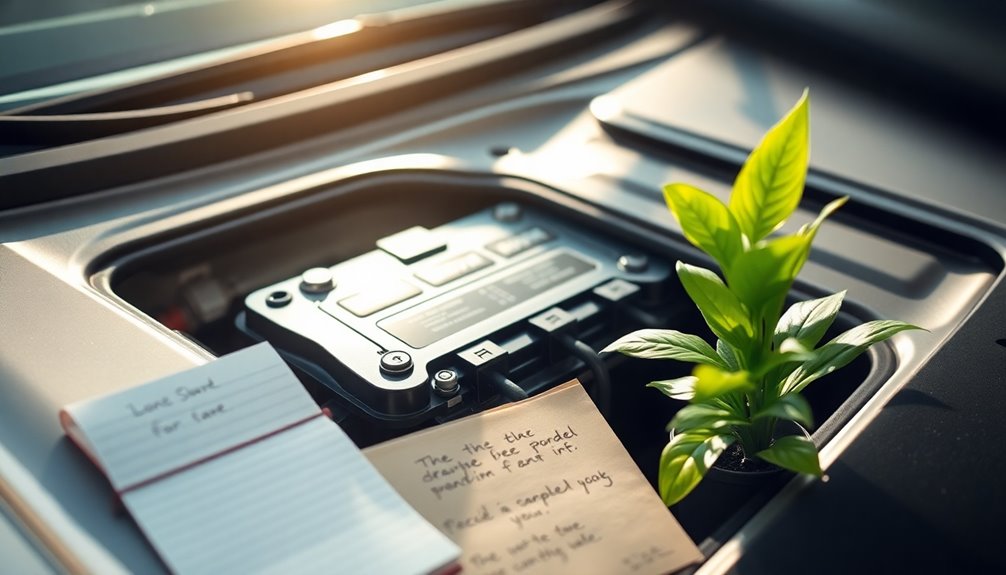When parking your car for weeks, start by disconnecting the negative terminal to reduce power drain. Use a smart maintainer or trickle charger to keep the battery charged, and store the vehicle in a cool, dry place away from extreme temperatures. Regularly check the battery’s condition and start the engine briefly every couple of weeks to circulate fluids. Keep these tips in mind, and you’ll find ways to guarantee your battery stays healthy during long-term storage.
Key Takeaways
- Disconnect the negative terminal to prevent electrical drain during extended parking.
- Use a smart maintainer or trickle charger to keep the battery charged.
- Park in a cool, dry, and level environment to reduce battery stress.
- Start the engine briefly every few weeks to circulate fluids and maintain charge.
- Regularly check battery health and connections to ensure optimal performance.

If you’re planning to leave your car parked for several weeks, it’s essential to take steps to keep the battery from dying. A dead battery can leave you stranded or force you to jump-start your vehicle once you’re ready to use it again. Proper battery maintenance during long-term storage is key to ensuring your car remains in good shape and ready to roll when you return. Start by cleaning the battery terminals and cables to remove any corrosion, which can interfere with electrical flow. Tighten any loose connections to prevent power drain and make sure the battery is securely mounted. If your battery is more than a few years old, consider testing its charge and overall health. Replacing an aging battery before storage can save you trouble later.
When it comes to car storage tips, the goal is to reduce electrical drain and prevent the battery from losing its charge. One effective method is to disconnect the negative terminal of the battery, which stops current flow and minimizes the risk of drainage from electronic devices or the vehicle’s systems. If disconnecting isn’t feasible, you can use a smart battery maintainer or trickle charger. These devices provide a steady, low-level charge that keeps the battery topped off without overcharging. Plugging in a maintainer is simple and can be left connected for the entire storage period, ensuring your battery remains healthy and ready to start your car when you return. Additionally, understanding the role of automation in vehicle maintenance can help you choose the best solutions for long-term storage.
Additionally, parking your vehicle in a cool, dry place helps preserve the battery and prevent other issues such as rust or tire deterioration. Avoid exposing your car to extreme temperatures, which can accelerate battery decline. If possible, position the vehicle on a level surface to prevent uneven tire pressure and stress on suspension components. Regularly checking the vehicle during the storage period is also a good idea. Start the engine every couple of weeks and let it run for a few minutes to circulate fluids and recharge the battery. If you’re not planning to start the car, at least turn on the accessories like the radio or interior lights briefly, but avoid leaving them on for extended periods, as this can drain the battery.
Frequently Asked Questions
Can Extreme Temperatures Damage My Car Battery During Long-Term Parking?
Extreme temperatures can indeed harm your car battery during long-term parking. High heat accelerates battery fluid evaporation and causes internal damage, while cold temperatures reduce the battery’s ability to hold a charge. To protect it, you should use battery insulation and ensure proper temperature regulation. These measures help maintain the battery’s health, preventing it from dying prematurely and ensuring your car starts smoothly when you’re ready to drive again.
How Often Should I Start My Car if Parked for Several Weeks?
You should start your car at least once every two to three weeks during parking intervals to maintain the battery’s health. This helps prevent the battery from discharging completely and keeps the alternator active. Regular battery maintenance, including checking for corrosion and ensuring proper fluid levels, is also essential. If you won’t be driving for an extended period, consider using a trickle charger or disconnecting the battery to preserve its lifespan.
Are There Specific Maintenance Tips for Electric Vehicle Batteries During Long Storage?
To sustain your electric vehicle battery during long storage, keep an eye on the battery temperature and avoid extreme heat or cold. Regularly check and follow specific charging routines, like keeping the battery charged between 50-80%, to prevent it from discharging completely. If possible, plug in your EV periodically to maintain ideal battery health. These steps help preserve your battery’s longevity and ensure it’s ready to go when you need it.
What Are the Signs My Car Battery Is Failing After Extended Parking?
You might notice your car struggles to start, which hints at potential battery issues. Signs of failing batteries include dimming headlights, slow cranking, or electrical glitches, often caused by battery corrosion or alternator failure. If your vehicle’s performance feels off after long parking periods, it’s wise to check the battery’s health. Early detection can save you from unexpected breakdowns; look out for these subtle signs before they become bigger problems.
Is It Better to Disconnect the Battery or Use a Trickle Charger?
When considering battery maintenance, you’ll find that using a trickle charger is often better than disconnecting the battery. Charging options like a trickle charger keep your battery topped up and prevent it from losing charge over time, ensuring it’s ready when you need it. Disconnecting the battery may prevent drain, but it can also risk losing your settings. For long-term parking, a trickle charger provides a steady, safe charge.
Conclusion
To keep your car battery alive during long parking periods, it’s a good idea to disconnect it or use a trickle charger. Some believe that just starting your car every few weeks can recharge the battery, but this isn’t always effective. In fact, modern cars with complex electronics may drain the battery faster if left unused. So, the best bet is to either disconnect the battery or use a maintenance charger to guarantee it stays healthy for when you need it.










